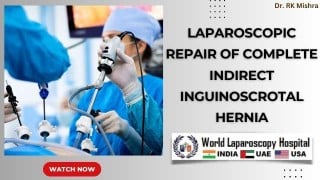Effective Treatment for Para-umbilical Hernia: IPOM Repair with Minimally Invasive Approach
Add to
Share
876 views
Report
2 years ago
Description
Para-umbilical hernias, characterized by a protrusion of abdominal tissue near the umbilicus, can cause discomfort, pain, and potential complications if left untreated. Fortunately, there is a highly effective treatment option available known as IPOM (Intraperitoneal Onlay Mesh) repair. This advanced technique, performed through a minimally invasive approach, offers patients a safe and efficient solution for para-umbilical hernia repair. The IPOM repair involves the use of a mesh implant placed inside the peritoneal cavity to reinforce the weakened abdominal wall and close the hernia defect. This mesh acts as a supportive barrier, preventing the hernia from protruding and reducing the risk of recurrence. The procedure is performed laparoscopically, utilizing small incisions in the abdomen through which specialized surgical instruments and a camera are inserted. The minimally invasive approach offers numerous advantages over traditional open surgery for para-umbilical hernia repair. It results in smaller incisions, reduced postoperative pain, faster recovery, shorter hospital stays, and improved cosmetic outcomes. Additionally, the laparoscopic technique allows for better visualization of the hernia defect, enabling precise placement of the mesh and ensuring optimal repair. The IPOM repair with a minimally invasive approach has shown excellent outcomes in terms of hernia recurrence rates. The mesh implant provides long-term stability and support to the abdominal wall, reducing the likelihood of hernia reoccurrence. Patients can experience relief from symptoms such as pain and discomfort, allowing them to resume their daily activities with minimal disruption. It is crucial for individuals with para-umbilical hernias to consult with a hernia specialist or a surgeon experienced in minimally invasive techniques to determine the most appropriate treatment plan. Factors such as the size of the hernia, patient's medical history, and individual needs will guide the decision-making process to ensure the best possible outcome. While IPOM repair with a minimally invasive approach is generally considered safe, it is essential to be aware of potential risks and complications associated with any surgical procedure. These may include infection, bleeding, mesh-related issues, or injury to surrounding structures. However, with proper patient selection and the expertise of a skilled surgical team, these risks can be minimized, leading to successful outcomes for the majority of patients. Para-umbilical hernias, characterized by a protrusion of abdominal tissue near the umbilicus, can be a source of discomfort and concern for individuals affected by this condition. Fortunately, there is an effective treatment option available known as Intraperitoneal Onlay Mesh (IPOM) repair. This innovative technique, performed through a minimally invasive approach, offers patients a safe and efficient solution for para-umbilical hernia repair. The IPOM repair involves the placement of a specialized mesh implant within the peritoneal cavity to reinforce the weakened abdominal wall and close the hernia defect. This mesh acts as a strong support system, preventing the hernia from protruding and reducing the risk of recurrence. The procedure is performed laparoscopically, utilizing small incisions in the abdomen through which specialized surgical instruments and a camera are inserted. The minimally invasive approach of IPOM repair offers several advantages over traditional open surgery. The use of smaller incisions results in less tissue trauma, reduced postoperative pain, faster recovery, shorter hospital stays, and improved cosmetic outcomes. Additionally, the laparoscopic technique allows for enhanced visualization of the hernia defect, enabling precise placement of the mesh and ensuring an optimal repair. IPOM repair with a minimally invasive approach has demonstrated excellent outcomes in terms of hernia recurrence rates. The mesh implant provides long-term stability and support to the weakened abdominal wall, significantly reducing the likelihood of hernia reoccurrence. Patients experience relief from symptoms such as pain, discomfort, and bulging, enabling them to regain their normal activities and quality of life. It is crucial for individuals with para-umbilical hernias to consult with a hernia specialist or a surgeon experienced in minimally invasive techniques to determine the most appropriate treatment plan. Factors such as the size and characteristics of the hernia, patient's medical history, and individual needs will guide the decision-making process to ensure the best possible outcome. While IPOM repair with a minimally invasive approach is generally considered safe, it is important to be aware of potential risks and complications associated with any surgical procedure. These may include infection, bleeding, mesh-related issues, or injury to surrounding structures. However, with proper patient selection, meticulous surgical technique, and the expertise of a skilled surgical team, these risks can be minimized, leading to successful outcomes for the majority of patients. Para-umbilical hernias can cause discomfort and pose potential complications for individuals affected by this condition. Discover the effective and minimally invasive treatment option known as Intraperitoneal Onlay Mesh (IPOM) repair. This advanced technique involves the placement of a specialized mesh implant within the peritoneal cavity to reinforce the weakened abdominal wall and close the hernia defect. With smaller incisions, reduced postoperative pain, and faster recovery, IPOM repair offers a safe and efficient solution for para-umbilical hernia repair. Explore how this innovative approach provides long-term stability, reduces the risk of hernia recurrence, and improves the quality of life for patients seeking effective treatment for para-umbilical hernias. In conclusion, IPOM repair with a minimally invasive approach stands as an effective and safe treatment option for para-umbilical hernias. This advanced technique offers long-term stability, reduces the risk of hernia recurrence, and improves patient outcomes. With its benefits of smaller incisions, faster recovery, and improved quality of life, IPOM repair with a minimally invasive approach represents a significant advancement in the field of para-umbilical hernia repair, providing individuals with a reliable and efficient solution for their condition.
Similar Videos






